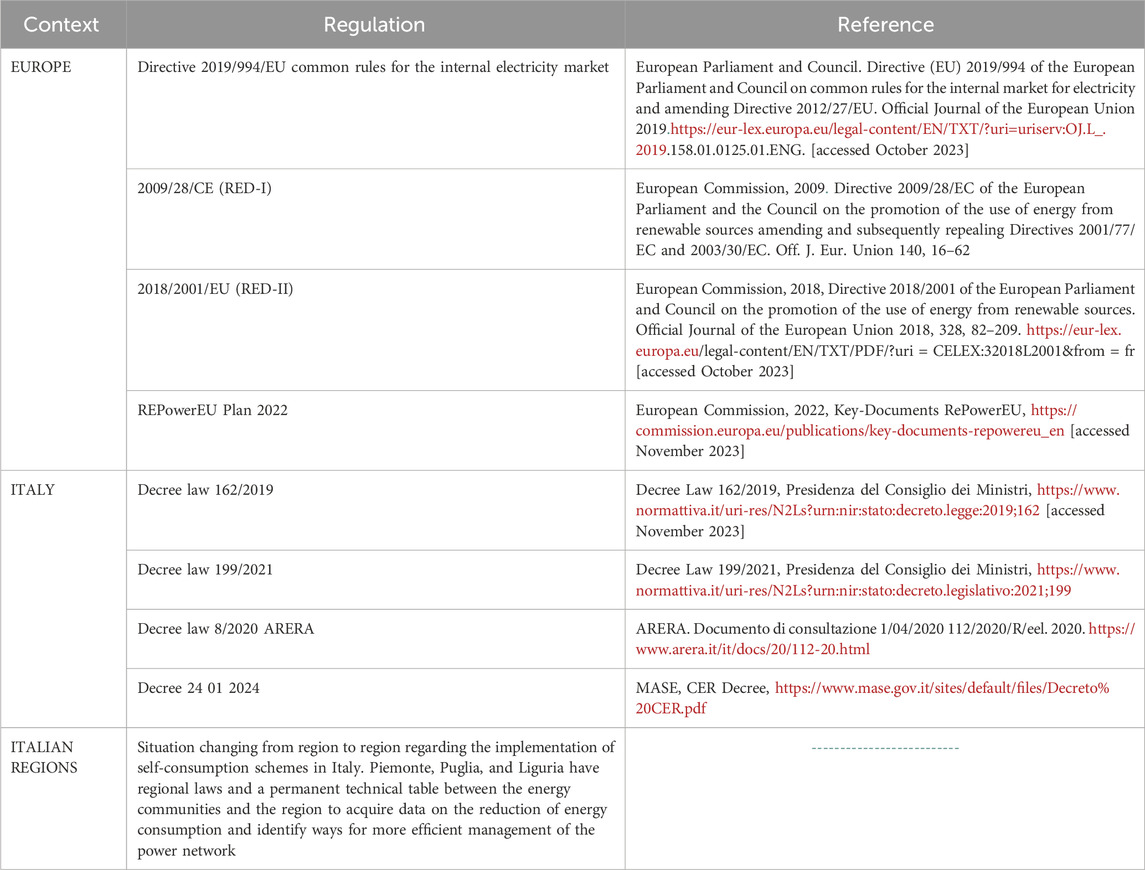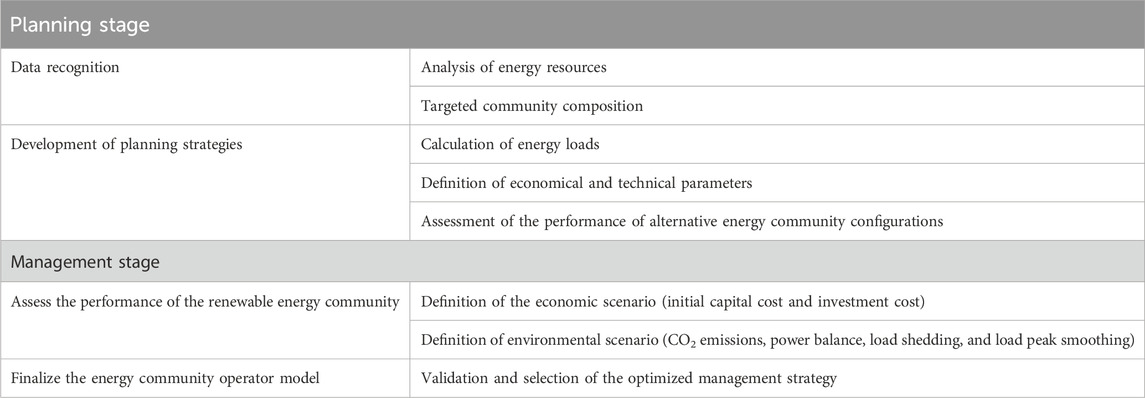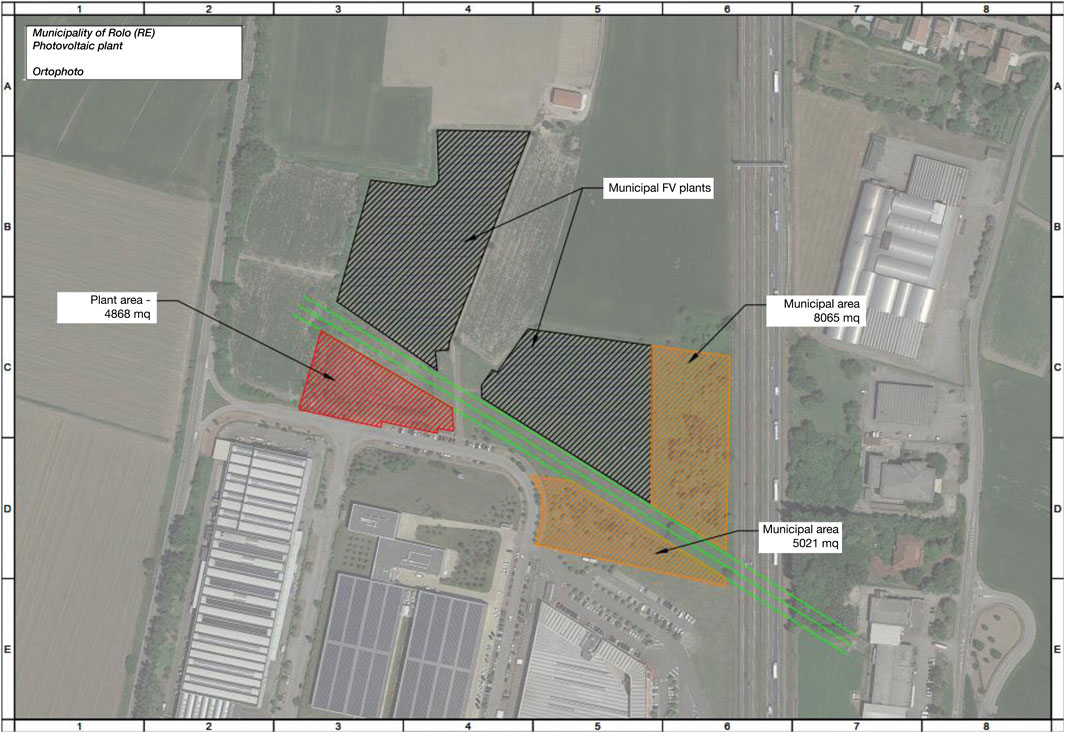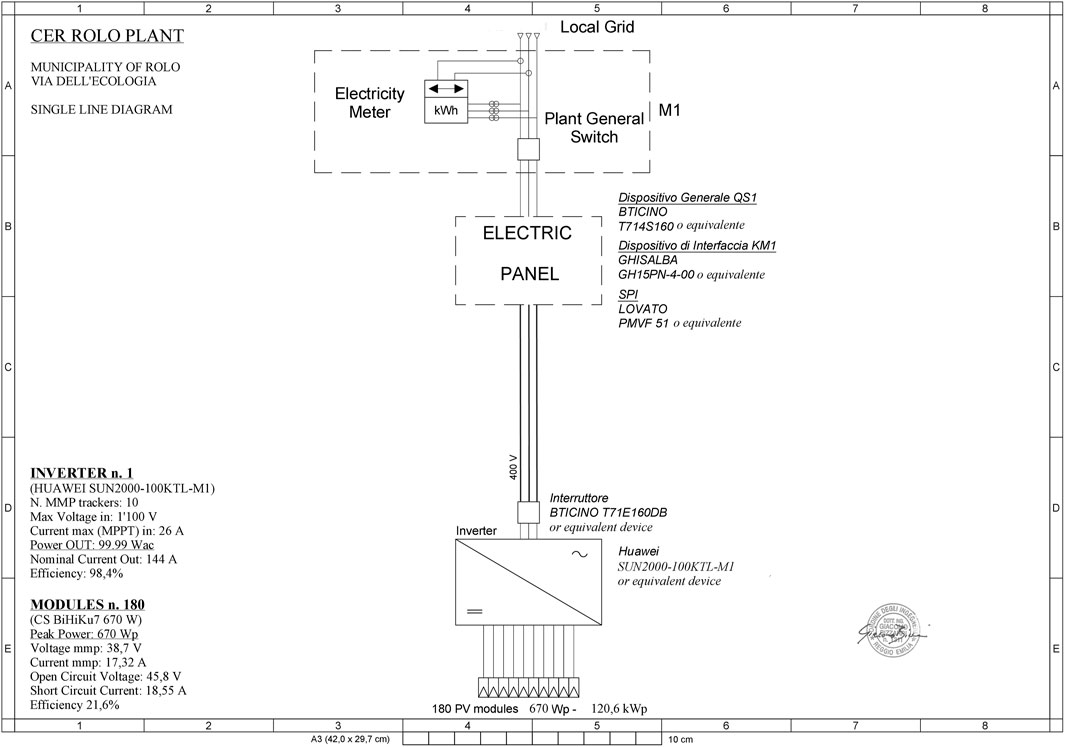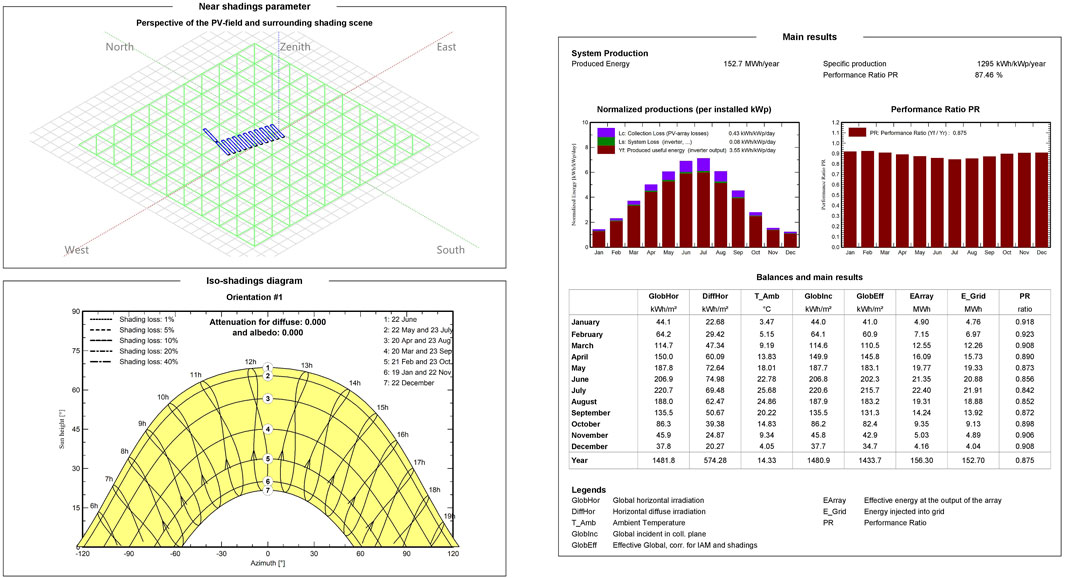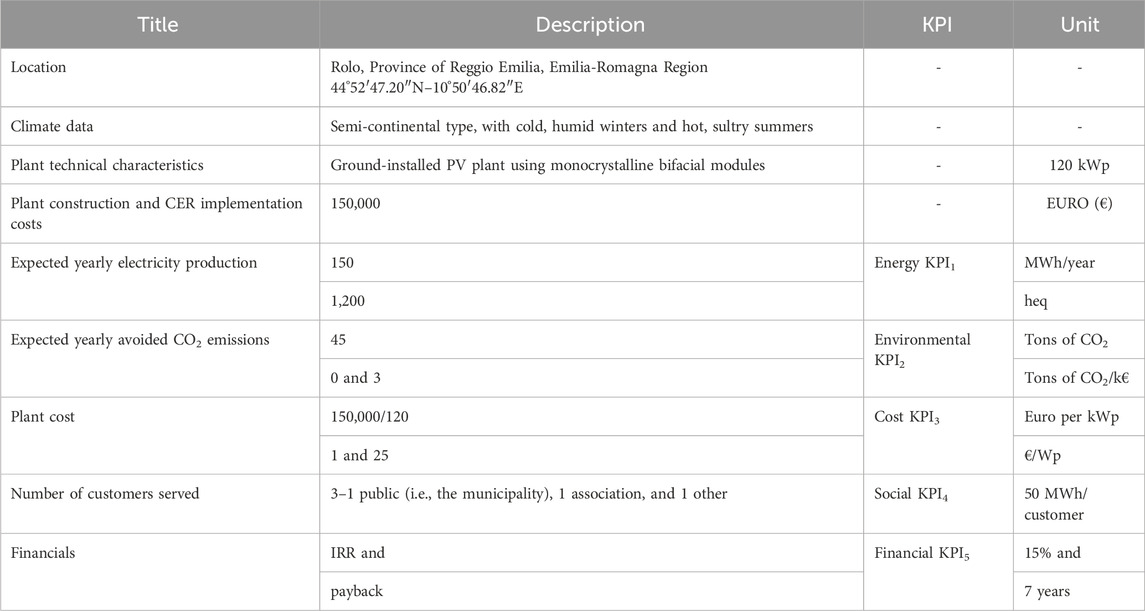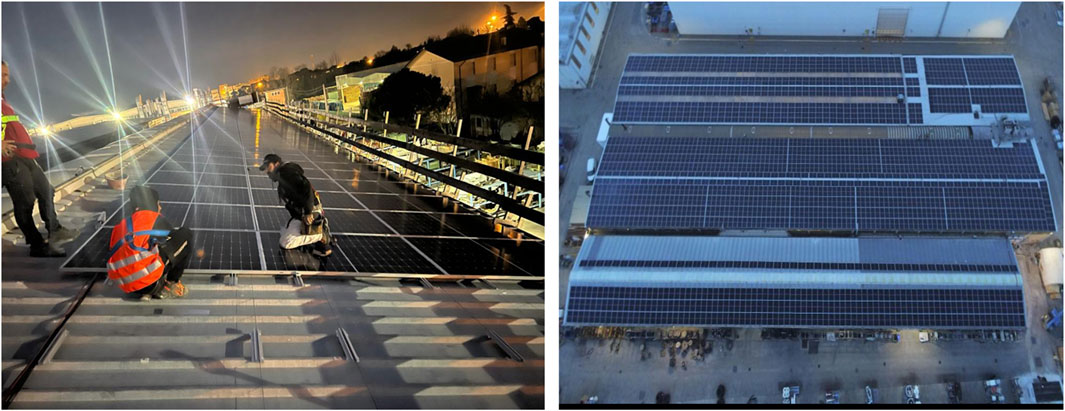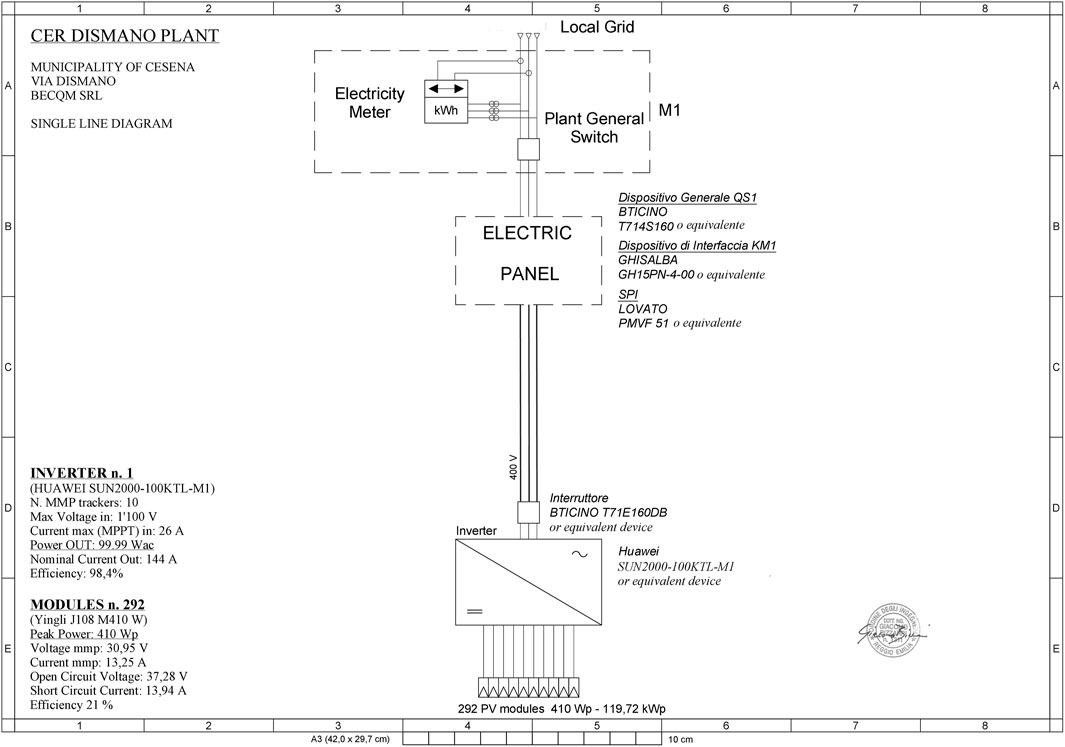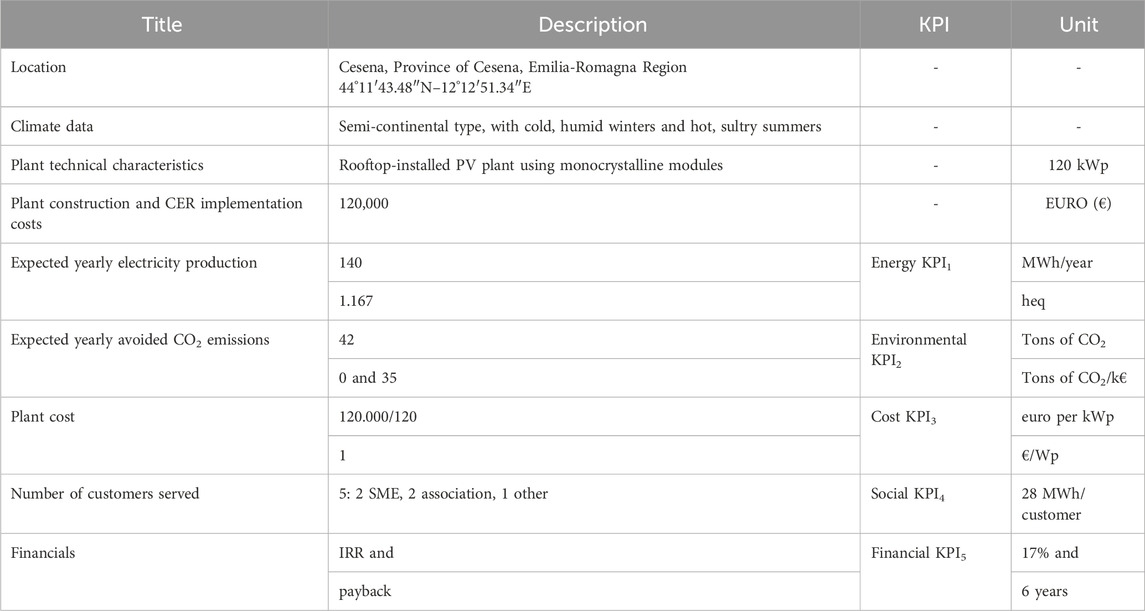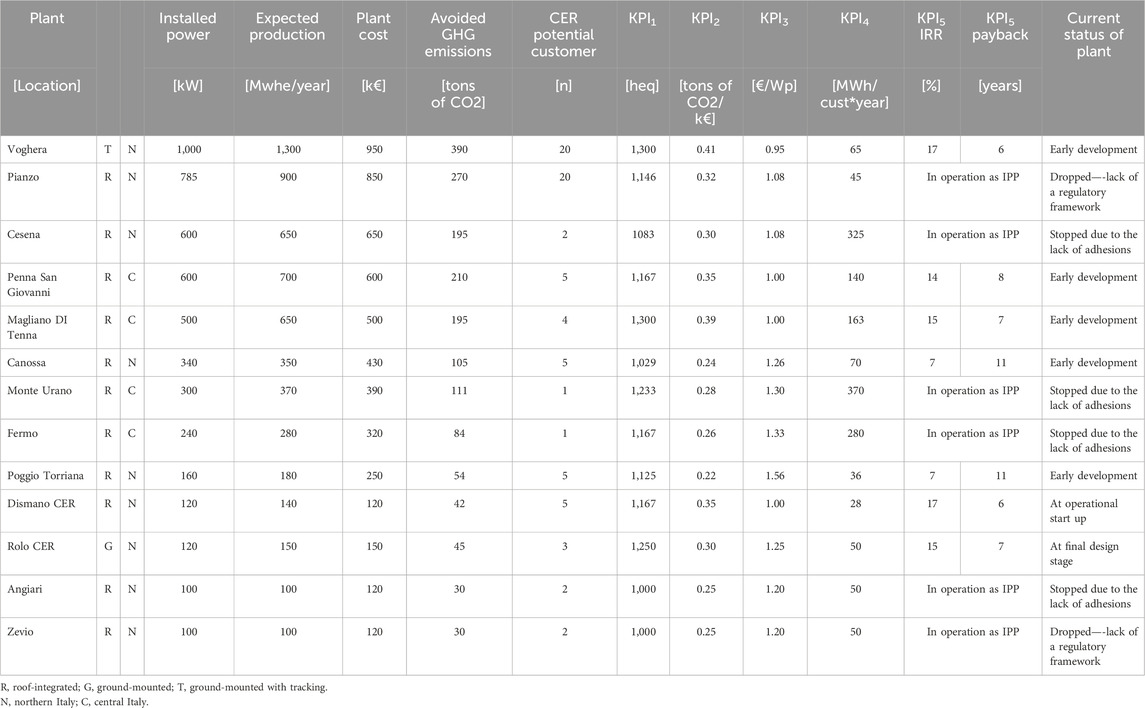- Department of Architecture, University of Ferrara, Ferrara, Italy
Renewable energy communities (RECs) are clean energy, emergent initiatives that invest in people cooperation in order to meet consumption needs and achieve environmental goals. The main aim of the study is to explore the potential of the renewable energy community in Italy by identifying a methodological perspective to describe the development processes and encourage the diffusion of multi-stakeholders’ initiatives across the Italian territory. To do so, we propose a general analysis of the renewable energy community framework, starting with the regulatory and technical–administrative state of the art that regulates renewable energy communities in Italy, based on information from the literature. Then, we interpret the procedure of REC initiatives by systematizing the steps of energy community formation and their characteristics, coming from a literature review of experiences achieved at a national level. Much literature is available on renewable energy technologies, but existing research lacks assessments regarding the description of the formation process of local energy systems applied to realized experiences. To do this, two strategies for the energy community are proposed through a comparative case study analysis to provide a framework for the emerging phenomenon and analyze and define the types of renewable energy communities based on realized experiences in Italy.
1 Introduction
Continuous growth of renewable energy systems has brought about a significant change in the structure of the power system, also influencing the procedures and business models related to the energy sector. As global energy consumption is expected to increase 54% from 2001 to 2025, providing clean energy to the global population is one of the greatest challenges in the 21st century in reducing energy-related pollution and greenhouse gas emissions.
In 2018, the European Directive RED-II on the promotion of the use of renewable energy sources has introduced the concept of renewable energy communities (RECs), identified as participatory local energy initiatives having positive benefits for acceptance of energy transition (European Commission, 2018). RECs are emergent initiatives with the potential to change the relations between end-users and other actors in the energy sector, such as citizens, social entrepreneurs, public authorities, and community organizations. Participants are active in the energy transition by jointly investing in producing, selling, distributing, and consuming renewable energy. The benefits of energy communities are expected to contribute to contrasting the climatic change, including positive regional, economic, and environmental impacts, which are identified as a major driver of public acceptance (Cohen et al., 2016).
Local citizen participation in renewable energy projects through renewable energy communities has resulted in substantial added value in terms of local acceptance of renewable energy (European Commission, 2009). However, participation and public acceptance in local energy communities are not only limited to the adoption of one specific energy technology or installation but also to the acceptance of all administrative and technological elements needed for an efficient local energy system.
The most advanced countries in this context are Germany, Denmark, and the Netherlands. However, in the last decade, Italy has emerged as an important country in the field of RECs (Azarova et al., 2019).
The roles and interactions of energy communities have been examined in the literature of the last 10 years as an emerging social phenomenon (Arentsen and Bellekom, 2014; Dóci et al., 2015). The agents of energy transition and concrete activities that can lead to community formation have been described (Bauwens, 2019; Bilardo et al., 2020). A very detailed framework to identify the studied factors for emergence of ECs is reported in Boveldt et al. (2022).
An accurate literature and regulatory review has been carried out to better understand and describe RECs in their highlights, particularly in reference to the strategic valorization of cooperation between citizens and local public entities.
In addition, we introduce an in-depth analysis of two realized REC experiences in Italy to show the potential of using RECs as a new strategy to address home energy savings in the current housing stock by assessing actions and measures that would help in coaching householders to achieve energy savings and low carbon goals.
We address the question as to how renewable energy communities can be practically realized and have the potential to contribute to energy transitions. To answer this question, we introduce two case studies for measuring the potential of social innovation and energy transition.
2 Methodology and KPI definition
For assessing the transition potential of renewable energy communities, it is necessary to start with exploring how RECs develop in a local-scale network. One of the main aims is to show how separate communities connect, learn from each other, use the same practices, and join for achieving a common goal. In the following sections, we provide a broader picture of the regulatory literature and procedures.
Section 2 describes the status of the current implementation of the REC model in Italy to identify the principal characteristics, such as the existing legislation and the incentive systems of REC regulatory aspects. A framework of renewable energy communities is defined, starting from the regulatory and technical–administrative state of the art that regulates renewable energy communities and other issues related to the transposition of European legislations in Italy.
Environmental and energy-based key performance indicators (KPIs) are frequently used to provide a neutral assessment of projects in the field of smart grids or smart district upgrades (Giordano et al., 2014; Bianco et al., 2021).
KPIs are used to formally identify key conditions to achieve local community involvement in forming REC initiatives, outline possible skills and strategies that can be tested within the emerging sector of energy communities, and evaluate the outcomes of REC strategies.
Key performance indicators represent a common framework to evaluate different sites from energy and environmental perspectives while also considering financial and social issues. Therefore, considering the complexity represented by energy communities, different energy vectors, and different stages of energy conversion, the defined KPIs are used to achieve uniform outcomes.
The following KPIs are defined in order to assess a specific site from a technical, environmental, and economic point of view; they are summarized in Table 1.
Section 3 presents two experiences of renewable energy communities in Italy. By means of the investigation of the selected case studies, the roles of several actors in the process (project managers, communities, and other local stakeholders involved at different stages in the development of the initiatives) are examined. Furthermore, an appropriate set of KPIs have been identified to establish a common framework to assess and compare different RECs, taking into account technical and environmental aspects.
Two case studies have been selected and analyzed through application of the KPI approach, representing a methodological approach to the regulatory context and experiences in Italy, and the presentation and discussion on possible weaknesses identified by the authors, especially in relation to the size of the plants and the extension of the group of actors involved in the implementation of the RECs.
3 Regulatory context at European level and transposition in Italy
In Europe, energy communities were initially promoted by the 2009/28/CE (RED-I) and then improved by the Directive 2018/2001/EU (RED-II) on the use of energy from renewable energy sources (RESs) and the Directive 2019/994/EU on common rules for the internal electricity market.
The European Directives aim to promote renewable energy use by setting a production target share of at least 32% and an increase in energy efficiency of 32.5% by 2030 (European Commission, 2018). These directives promote the establishment of two different types of energy communities: RECs and citizen energy communities (CECs). Both the RECs and CECs are legal entities based on open and voluntary participation, effectively controlled by shareholders or members, with the purpose of achieving environmental, economic, and social benefits rather than financial profits (European Commission, 2009; 2018).
According to European Directives, energy communities have the right to produce, consume, store, and sell electricity; exchange energy within the same community; and access energy markets in a non-discriminatory way (European Commission, 2018; European Parliament and Council, 2019). Moreover, the emerging role of prosumers and renewable energy communities is supported, indicating the willingness to give citizens a leading role in the ambitious process of the energy transition to climate neutrality by 2050. In the energy production sector, the prosumer is the main actor of the energy revolution due to active participation in the energy market by consuming self-produced energy and injecting the surplus into the grid.
The recent international tensions, particularly related to the war in Ukraine, have heightened the need to accelerate the spread of renewable energy in the European Union to gradually eliminate dependence on fossil fuels. On the 18th of May 2022, the REPowerEU Plan was promoted to modify the Directives with the aim of speeding up the procedures and accelerating the green transition (European Commission, 2022).
Italy is one of the European countries to have significantly promoted the installation of RESs in the last 10 years, with a great focus on community self-consumption. On the basis of the RED I Directive, the National Guidelines on Renewable Energy (Decree 28/2011) have been adopted to define the framework of permissions and procedures for renewable installations.
Afterward, the RED-II Directive was partially transposed by Decree-Law 162/2019, which established a transitory regime stating the characteristics of jointly acting self-consumers or RECs. According to this Decree, physical persons, companies, local authorities, and local communities are allowed to participate in RECs, but participation must not constitute the main professional activity (Decree-Law 162/2019, 2019). The emerging role of prosumers and communities is supported, indicating the willingness to give citizens a leading role in the ambitious process of the energy transition to climate neutrality by 2050.
Finally, the RED-II Directive has been transposed into law by Decree Law 199/2021, which has been in force in Italy since 15th December 2021. The Decree introduces a set of rules in cooperation with the recent Resilience and Re-start National Plan (PNRR) (Decree Law 199/2021, 2021).
On 1 April 2020, ARERA, the Italian Energy Regulatory Authority, published a consultation document containing guidelines for the regulation of economic transactions in jointly acting self-consumption schemes and RECs, introducing important innovations and establishing an economic incentive for participants in the self-consumption schemes linked to the reduced use of electricity from the grid (ARERA, 2020):
• The electricity produced is the electricity fed into the grid after deduction of the conventional loss coefficients.
• The electricity consumed is intended to come from the grid.
• Shared electricity for self-consumption (or simply shared electricity) for each hour is the minimum between the sum of the electricity produced and the sum of the electricity consumed through the connection points of the jointly acting self-consumers or a REC.
On 22 December 2020, the Gestore Servizi Energetici (GSE), the Energy Services Manager operating in Italy, issued a document containing the technical rules for accessing the incentive tariff for jointly acting self-consumers and RECs and providing important clarifications about roles and responsibilities. This document represents, currently, the most recent regulations for self-consumption in Italy (Gestore Servizi Energetici, 2020).
Effective from 24 January 2024, a new decree is designed to encourage the proliferation of collective forms of energy production and self-consumption from renewable sources. The decree introduces important issues to promote the development of RECs in Italy. The decree also introduces an incentive tariff on renewable energy produced and shared, applicable nationwide, to stimulate the generation and sharing of renewable energy throughout the country (MASE, 2024).
Finally, there is a situation changing from region to region regarding the implementation of self-consumption schemes in Italy. Piemonte, Puglia, and Liguria have regional laws and a permanent technical table between the energy communities and the region to acquire data on the reduction of energy consumption and identify ways for more efficient management of the power network (Consiglio Regionale Piemonte, 2018). Table 2 summarizes the legislative framework at European and national levels.
4 Establishment and management of RECs
The establishment and management of renewable energy communities require knowledge and compliance with multiple rules of legislative, regulatory, technical, and economic aspects. Moreover, in the planning stage, the long-term goals of the community and any possible changes in external conditions should be taken into account.
According to the definition provided by Directive RED-II, a renewable energy self-consumer is “A final customer operating within its premises located within confined boundaries or, where permitted by a Member State, within other premises, who generates renewable electricity for its consumption, and who may store or sell self-generated renewable electricity, provided that, for a non-household renewables self-consumer, those activities do not constitute its primary commercial or professional activity” (European Commission, 2018). Moreover, the Directive (EU) 2019/944 establishes common rules for the generation, transmission, distribution, energy storage, and supply of electricity, as well as consumer protection provisions, with a view to creating competitive, consumer-centered, flexible, fair, and transparent electricity markets.
RECs are often locally situated in close social proximity to residents and are already part of local structures, with great potential to raising awareness locally and gaining public support for low-carbon energy and energy-saving projects. In the energy production sector, the prosumer appears as the main actor of the energy revolution, as he actively participates in the energy market by consuming self-produced energy and injecting the surplus into the grid. The shareholders and members could be natural persons, small–medium enterprises (SMEs), as well as local authorities, including municipalities (Di Silvestre et al., 2021).
Differently from the European REC, the Italian REC can only manage electricity by renewable energy sources and requires that its members be individually connected to the public distribution grid. The Energy Services Manager (the Italian GSE) provides an incentive rate of 11€/kWh for each kWh of community’s shared electric energy, evaluated as the hourly minimum between the overall electricity fed into the grid by the REC and the overall electricity withdrawn from it (Gestore Servizi Energetici, 2020).
The main characteristics of an REC in Italy can be summarized as follows:
• Main actors. By following the legislation, both private users of the residential sector and SMEs are free to participate in renewable energy community initiatives. In Italy, the share of SMEs among all enterprises is higher than the average European value, accounting for 57% of the national production of goods and services (Dal Cin et al., 2022). SMEs can participate only if the activity does not constitute the main commercial or industrial activity. In addition, public bodies (e.g., municipalities), research institutions, and religious bodies are admitted actors.
• Producer. A producer is a natural or legal person who produces electricity and does not necessarily coincide with the owner of the production plant. He must have obtained the electrical workshop license or company code required by current legislations and signed the operating regulations.
• End user/customer. All consumers, including those with low income or vulnerable, can participate in an open and voluntary manner. The end customer must be the owner of the connection point of the consumption unit and, therefore, the holder of the electricity bill.
• Financial contributions. These can be paid for a period of 20 years, starting from the commercial start date of the system. For each KWh of shared electricity, the GSE recognizes a unitary contribution, equal to the transmission tariff for low-voltage users, and a premium contribution regulated by the current legislation.
The main steps that characterize a renewable energy community formation process are reported in Table 3. The planning stage concerns the first actions taken to establish an energy community and ensure the achievement of goals for decision-makers: the composition of existing and prospective consumers is defined, the analysis of the energy resources is performed, and the calculation of electrical loads is carried out. Based on an analysis of the energy resources of the area, the energy community can include the individuated energy sources. A second planning stage concerns developing alternative energy community configurations by using dedicated software specifying different sets of energy sources available for use (Gjorgievski et al., 2021).
In the management stage, the business and operator models are defined. An economic scenario (initial capital cost and investment cost) and an energy scenario (CO2 emissions, power balance, load shedding, and load peak smoothing) are modeled. The community configuration, taking into account the choices of the decision-makers, ensures that the sustainability of the project is defined. A management community platform in the local energy market can help end users significantly reduce their overall electricity consumption: consumers can form coalitions with other consumers to buy their excess generation directly. An optimization model can be built by using artificial intelligence from open-source and free software to create multi-criteria management systems.
The active development of local energy communities in the EU establishes new practices that implement both advanced economic and social principles. For example, the so-called co-assembly principle enables the platform management of aggregated sets of distributed energy. Such practices can be used both at the local level within microgrids (where such platforms form a co-assembled energy community) and at the national and even regional levels of large energy systems. In this case, platform solutions are used to create virtual power plants and integrate electricity storage devices and controlled loads into wholesale market facilities (Tomlin et al., 2022).
Some projects propose an energy consultant business model to support local energy communities (GECO, 2020). The creation of a regulatory framework for the operation of microgrids to develop business practices and their integration into communities is of significant practical importance for consumers included in these microgrids since it solves the problem of increasing electricity prices (Walker et al., 2021).
Other examples of energy communities that implement the co-development principle are eco-villages (Homan et al., 2019), in which houses in the neighborhood are generally equipped with solar panels, micro-combined heat and power (CHP), heat pumps, power storage systems, charging stations for electric vehicles, and a tie line connecting to the grid. A microgrid based on these energy and flexibility sources is managed by smart integrated decentralized energy systems for optimal management. The company also provides peer-to-peer electricity trading between microgrid facilities belonging to different owners.
5 Case study in the Italian territory
Two case studies in the Italian territory have been compared through the application of the proposed KPIs.
The analyses have been developed in Pianura Padana (the large plain in northern Italy). This siting shifts the focus of CERs to photovoltaic (PV) plants, i.e., solar sources, since the availability of water head or wind resources is very limited in most of the sites of this geographical area (i.e., in Pianura Padana, there are not many height gaps that can be exploited for hydropower, and wind dynamics are limited by the geographical shape of the whole area). Biomass plants are also complicated and have been disregarded in this study since their success is strictly dependent on the availability of a reliable and continuous supply chain.
The selected cases are as follows: i) Rolo Municipality PV CER and ii) Dismano PV CER.
The first initiative has been planned by a public entity to mitigate its energy expenditure, whereas the second initiative has been promoted by a local independent power producer (IPP) to provide CER energy delivery services to the industries settled in the industrial area of Cesena Nord.
Furthermore, the choice of these plants is very interesting since they belong to two different plant typologies: the first is ground-mounted and the second is rooftop-integrated. The fact that the plants belong to different categories of photovoltaic installations allows for investigating the best sizing for each, enabling developers to optimize both the energy and financial payback of the investment.
Once the plant construction costs are gathered and the expected revenues are calculated, one can determine the energy and financial payback of the initiatives. The availability of a large amount of similar data collected from other plants of different sizes built during the same period helps in defining the best power range that must be chased to maximize the investment benefits, highlighting a size effect. Finally, the causes of these size patterns have been explained in the next section, demonstrating that the two chosen case studies can be considered ideally planned.
5.1 Rolo CER
Rolo CER has been promoted by Comune di Rolo to mitigate the risk of purchasing electricity from the grid at uncontrolled prices because of exogenous factors such as the war in Ukraine or the COVID crisis. The Municipality, therefore, commissioned a study from the Department of Architecture at the University of Ferrara to find out the best site to host a PV plant large enough to meet its daytime energy demand, together with the demand for few other possible actors interested in limiting their electricity supply risk (Bizzarri, 2023).
The study found that the best site, among the ones in the availability of the Municipality, was an area of approximately 5,000 m2, in the proximity of an existing larger PV plant in operation since 2010 (Figure 1). This localization is particularly desirable due to the possibility of sharing existing infrastructure with a nearby plant, such as surveillance and monitoring systems, and the presence of an adjacent electric distribution cabinet, which lowers connection costs. The PV design has been developed considering that the future PV plant will have to meet an expected production target ranging between 100 and 150 MWh/year, in line with the yearly daytime energy requirements of the Municipality of Rolo. It is important to remember that the target of the CER is to seek self-production that matches the electricity demand of the actors involved in the community. The fact that the solar plants produce electricity entirely during the daytime leads to a focus on the demand from daytime public activities, such as schools and public offices, neglecting the requirement of public lighting being asynchronous to the CER electricity self-production. Given the available land area, the result of the analyses leads to a PV plant size of approximately 100/120 kWp to be connected directly to the near distribution cabinet through the local low-voltage grid. This is of pivotal importance since the possibility of avoiding the necessity of current transformation into medium voltage, with the related significant expenses (e.g., cabinet, trafo, and cells), would significantly increase the plant’s general costs.
The PV CER electric single-line diagram, as shown in Figure 2, demonstrates that the plant displays a very easy connection scheme, avoiding all the complexity related to medium-voltage plants.
It is finally important to underline that this solution is also compliant with the first CER norms, which limited access to the CER mechanism to plants only connected to the low-voltage grid.
A cost analysis has then been developed, asking for specific quotations from the main suppliers of the sector (e.g., module and inverter manufacturers and frame suppliers), finding a probable overall cost of 150,000 euros for the PV plant and CER implementation, as a result of 35 k€ for PV modules, 5 k€ for inverters, 30 k€ for module support frames (ground-mounted), 15 k€ for plant BOS; 25 k€ for installation activities, 10 k€ for civil works (e.g., fences), and 30 k€ for other general costs. If the plant exceeds the power compliant with a low-voltage connection, additional costs of at least 50 k€ (from supplier quotations) should be considered, making this option less desirable unless much higher installed power is necessary. The reason for these extra costs is that once one connects to a medium-voltage grid, the necessity of installing additional devices and civil works must be considered: trafo, electric panels and cells, disconnectors, cabinets, etc., but these are seldom necessary in low-voltage plants. These costs can be mitigated if the plant sizes are large enough to mitigate them through much larger production.
The energy simulation, as shown in Figure 3, has been run using very reliable software PVsyst 7.2 (currently one of the most used in the sector). This simulation used the solar radiation and meteorological data from the CMSAF Meteo Database, compiled from satellite and other meteorological recordings spanning the period 2008–2016. This analysis estimates an available solar resource and specific electricity production of 1,300 kWhe/kWp, resulting in an expected CER production of 150 MWh/year. It should be noted that this software program and the CMSAF database have been adopted as they are highly suitable and reliable for the selected case study. At the same time, other calculation tools, such as PVGIS, or other good, referenced databases, such as Meteonorm (built over 1990–2006 data), might also be considered. The sensitivity analyses of the predictions that can be obtained through different software programs represent a very interesting topic that deserves a specific dissertation. However, for the sake of remaining focused on the main subject of the current research in this paper, we avoid the risk of going off-topic. The authors decided to simply present data obtained through computations provided by PVsyst 7.2 software using the CMSAF Meteo Database.
Environmental benefits have also been evaluated in terms of GHG emissions, specifically in terms of CO2. Benefits coming from electricity self-production have been determined in all the cases presented in the article, adopting the emission coefficient provided by ISPRA (the National Environmental Agency) in its periodic bulletin (ISPRA et al., 2024). The most recent data show gross benefits that might be estimated at 270 g/kWhe; this value has been increased by 10%, up to 300 g/kWhe, if one considers that electricity from CERs is used in the neighborhood and is therefore not affected by high-voltage transmission losses, which might be evaluated at about 10%.
A financial analysis has been carried out under the following assumptions:
- Full equity investment.
- Inflation rate: 2%.
- Utilization ratio, i.e., percentage of CER contribution to the overall plant production: 70%.
- Electricity value (gross price), linked to inflation: 8 €cent/kWh;
- CER financial contribution fixed over 20 years: 12 €cent/kWh applied over 70% of the production.
- Operating expenditures (OpEx) for plant operation and management (O&M), 30% of the revenues.
Without entering the rationale of the benefit distributions among the CER participants, ruled by the specific statute, the financial analysis in a full equity scheme helps provide a full picture of the quality of the general investment under stress test conditions, being the most conservative scenario, since it does not benefit from the help given by the financial leverage on debt. Results yield an internal rate of return (IRR) of 15% and a payback period of 7 years, demonstrating the sustainability of the general investment.
The main CER data and the results of the analysis in terms of KPIs are summarized in Table 4.
5.2 Dismano CER
Dismano CER has been promoted by Bequerel Spa, a local independent power producer (IPP), to provide CER energy delivery services to the industries settled in the industrial area of Cesena Nord.
This plant is a rooftop-integrated photovoltaic system, built over the south slope of a warehouse in the Cesena industrial area of Via Dismano.
In this case, Bequerel self-financed and built the whole plant, making it available to the nascent CER, which should include some industrial prosumers settled in the area who seek to limit their electricity supply risk. Other customers also show a direct interest in attending the community, and the same municipality of Cesena has encouraged the IPP to broaden the participation of other local customers.
The plant, sized at 11,972 kWp, is currently in the final stage of construction (see Figure 4, where the Dismano PV CER. Construction works; PV plant view from above is represented).
As in Rolo, Via Dismano plant benefits from the possibility of connecting to the low-voltage local grid using an existing cabinet operated by the local distributor. This helps in reducing the overall cost of the plant since there is no necessity of providing it with conversion units and trafo (see single-line diagram in Figure 5).
In this case, the plant being in the final phase of construction, a precise cost report is already available, giving an overall cost of 120,000 euros for the PV plant, as a result of 35 k€ for PV modules, 5 k€ for inverters, 10 k€ for module support frames (ground-mounted), 15 k€ for plant BOS, 15 k€ for installation activities, 10 k€ for civil works, and 30 k€ for other general costs.
The energy simulation has been developed using PVsyst 7.2 software, referenced over the CMSAF Meteo Database, built over data from satellite and other meteo recordings spanning the period 2007–2016, obtaining a specific electricity production of 1,150 kWhe/kWp, for an expected CER production of 140 MWh/year.
For the financial analysis, the same assumptions used in Rolo are considered, finding an IRR of 17% and a payback period of 6 years, which confirm the sustainability of the general investment as well.
The main CER data and the results of the analysis in terms of KPIs are summarized in Table 5.
Again, the possibility of avoiding the voltage transformation section, thanks to the possibility of connecting to the low-voltage local grid, leads to a general savings of approximately 50 k€, according to the quotation received from the major sector supplier. Similarly to Rolo, one can demonstrate that in that case, payback is protracted by 2.5 years and that IRR decreases to 11% (still satisfactory).
6 Results
In order to provide a full picture of the current Italian market, some other case studies are presented; even though they are not described in the same detail as the two illustrated in Section 5, their main data and the related KPIs are given. These plants are currently at a different stage of development, or their possible status of CER has been abandoned due to the barriers that have stopped the CER formation process.
This basket of initiatives is of interest since it allows extending the focus to a larger array of plants spread over the Italian territories, characterized by larger peak power.
The main data and the related KPIs of these other initiatives are provided in Table 6; values in green show the best figures according to each KPI, and red values are the worst in the sample.
Results show that, theoretically, all PV plants in Italy might have solid financial fundamentals and a certain financial feasibility; the good solar resource, together with the current cost of technology, always justifies the adoption of PV plants. The possibility of sharing electricity within CER, of course, boosts the financial indexes, facilitating the adoption of these plants. The main barrier, so far, has been the lack of a reliable regulatory framework that has led investors and IPPs to prefer standard plant configurations rather than investing time and money in the fulfillment of CERs.
The two selected cases show some recurrent patterns that should be underlined. At first, low-voltage plants are characterized by sustainable costs and benefit from a scale effect given by their simple electric configuration (no need to install medium-voltage plant units); however, at the same time, they yield a limited amount of electricity to the grid. Therefore, their attractive potential in terms of CERs is soon exhausted, showing a scarce potential in terms of CER capacity to assent customer adhesion requests.
To summarize the potential of these, small plants stay in their good energy and financial indexes, and their limit is in their scarce potential in terms of CER attractiveness.
Larger plants have the potential to share more electricity, but at the same time, they show the worst KPIs for plants whose peak power stays in the range of 150–400 kW.
As a first comment, one might consider that in the case of a limited number of CER applicants, small PV plants whose power allows a connection with the low-voltage grid should represent a desirable option, whereas in the case of large numbers of possible CER participants, one should dimension the CER plant in order to have the highest possible power installed (within the current limit of 1 MW).
This analysis is a first step, and the collection of operational data will help confirm or further specify these early findings. However, some of the considerations above might already be taken as a practical guideline to define the better size of a rising CER in case the promoter has to dimension it according to the cost and parterre of possible customers.
7 Discussion and conclusion
The result of this work is first to describe the methodological perspective with which it is possible to analyze the local development processes carried out by energy communities. Second, a full description of two rising energy communities is provided. These two case studies are particularly relevant since they belong to two different typologies of renewable plants and are driven by different actors, public and private, hence demonstrating that the CER scheme presents a wide range of feasibility schemes.
The energy and financial analyses that have been carried out demonstrate that both plants show satisfactory energy and economic payback, even in the absence of bank financial support (i.e., full equity investment), independently of the future governance policy that the CER would adopt in relation to its statute.
Finally, it has been demonstrated that plants whose power is limited to low-voltage grid connections (i.e., according to the Italian grid code, lower than 120 kWp), result in being particularly cost-effective since they have the possibility of reducing the investment payback period by at least 2 years if compared to plants having higher power but connected to a medium-voltage grid.
In general, developing simpler configurations of RECs–as in the proposed case studies, allows prosumers to substantially improve the economic and environmental benefits with respect to what they would obtain if they operated independently, while achieving results in line with more complex configurations. A simple consumer, not owning any conversion or storage unit, can join and benefit from the EC. The simple consumer allows for improving the community level of self-consumption and, therefore, economic savings.
The limitation of these small plants is, however, that they do not fit with many CER adhesion requests. In this case, the limited amount of electricity given by their operations soon entails a shortage of shared resources. In this case, larger plants are more desirable.
As a last consideration, since the RECs are modeled as organizations of prosumers and no district heating network is considered, the thermal demand, differently from the electrical demand, must be individually fulfilled by each prosumer. Further improvements to this work should consider the design of a possible district heating network that connects the community’s members to verify whether sharing thermal energy can facilitate a wider exploitation of centralized units that fulfill the aggregated heating demand of the entire community.
Data availability statement
The raw data supporting the conclusion of this article will be made available by the authors, without undue reservation.
Author contributions
SB: Writing–original draft, Writing–review and editing, Supervision, Conceptualization, Methodology. GB: Writing–original draft, Writing–review and editing, Data curation, Formal analysis. EB: Writing–review and editing, Data Curation, Formal analysis.
Funding
The author(s) declare that financial support was received for the research, authorship, and/or publication of this article. This work was supported by the FIRD2023 project (2023-FARL.L-FIRD_architettura_BS) “Renewable energy communities–methodological perspectives and framework models,” funded by the Department of Architecture of the University of Ferrara (local research projects).
Acknowledgments
The authors would like to thank Bequerel Electric Spa for the courtesy of the images and case study data. They express their gratitude to Enrica Boldrin for energy simulations (Figure 3).
Conflict of interest
The authors declare that the research was conducted in the absence of any commercial or financial relationships that could be construed as a potential conflict of interest.
Publisher’s note
All claims expressed in this article are solely those of the authors and do not necessarily represent those of their affiliated organizations, or those of the publisher, the editors, and the reviewers. Any product that may be evaluated in this article, or claim that may be made by its manufacturer, is not guaranteed or endorsed by the publisher.
Abbreviations
Capex, CAPital Expenditure, is the money spent to buy, maintain, or improve the CER asset (i.e., the plant); GHG, greenhouse gas, in this paper, specifically carbon dioxide; IPP, independent power producer—IPP is the organization or the entity that manages the operation of the CER plant; IRR, internal rate of return; REC, renewable energy communities; RES, renewable energy source.
References
Arentsen, M., and Bellekom, S. (2014). Power to the people: local energy initiatives as seedbeds of innovation? Energy, Sustain. Soc. 4, 2. doi:10.1186/2192-0567-4-2
ARERA (2020). Documento di consultazione 1/04/2020 112/2020/R/eel. Available at: https://www.arera.it/it/docs/20/112-20.html (Accessed October, 2023).
Azarova, V., Cohen, J., Friedl, C., and Reichl, J. (2019). Designing local renewable energy communities to increase social acceptance: evidence from a choice experiment in Austria, Germany, Italy, and Switzerland. Energy Policy 132, 1176–1183. doi:10.1016/j.enpol.2019.06.067
Bauwens, T. (2019). Analyzing the determinants of the size of investments by community renewable energy members: findings and policy implications from Flanders. Energy Policy 129, 841–852. doi:10.1016/j.enpol.2019.02.067
Bianco, G., Bonvini, B., Bracco, S., Delfino, F., Laiolo, P., and Piazza, G. (2021). Key performance indicators for an energy community based on sustainable technologies. Sustainability 13, 8789. doi:10.3390/su13168789
Bilardo, M., Cattaneo, F., Dioni, E., Liberi, E., Milocco, L., and Serale, G. (2020). Community Energy for enhancing the energy transition. CERN IdeaSquare J. Exp. Innovation, 7–18. doi:10.23726/CIJ.2020.1050
Bizzarri, G. (2023). Progetto di fattibilità tecnica ed economica, consulenza e assistenza scientifica per la definizione di uno Studio volto alla realizzazione di un impianto fotovoltaico su area comunale per futura Comunita’ Energetica Rinnovabile – Incarico Determina CIG: Z65395A815 – CU: VDP55V”. Archive of Rolo Municipality Year 2023.
Boveldt, L. M. L., Coosemans, T., and Ramirez Camargo, L. (2022). A transition perspective on Energy Communities: a systematic literature review and research agenda. Renew. Sustain. Energy Rev. 163, 112479. 1364-0321. doi:10.1016/j.rser.2022.112479
Cohen, J. J., Moeltner, K., Reichl, J., and Schmidthaler, M. (2016). An empirical analysis of local opposition to new transmission lines across the EU-27. Energy J. 37 (3), 59–82. doi:10.5547/01956574.37.3.jcoh
Consiglio Regionale Piemonte (2018). Legge regionale n◦12 del 3 agosto 2018 sulla promozione dell’istituzione delle comunità energetiche. Arianna Banca dati leggi Reg. del Piemonte. Available at: http://arianna.consiglioregionale.piemonte.it/ariaint/TESTO?LAYOUT=PRESENTAZIONE&TIPODOC=LEGGI&LEGGE=12&LEGGEANNO=2018 (Accessed October, 2023).
Dal Cin, E., Carraro, G., Volpato, G., Lazzaretto, A., and Danieli, P. (2022). A multi-criteria approach to optimize the design-operation of Energy Communities considering economic-environmental objectives and demand side management. Energy Convers. Manag. 263, 115677. doi:10.1016/j.enconman.2022.115677
Decree lLaw 162/2019 (2019). Presidenza del Consiglio dei Ministri. Available at: https://www.normattiva.it/uri-res/N2Ls?urn:nir:stato:decreto.legge (Accessed November, 2023).162
Decree lLaw 199/2021 (2021). Presidenza del Consiglio dei Ministri. Available at: https://www.normattiva.it/uri-res/N2Ls?urn:nir:stato:decreto.legislativo.
Di Silvestre, M. L., Ippolito, M. G., Riva Sanseverino, E., Sciume, G., and Vasile, A. (2021). Energy self-consumers and renewable energy communities in Italy: new actors of the electric power systems. Renew. Sustain. Energy Rev. 151, 111565. 1364-0321. doi:10.1016/j.rser.2021.111565
Dóci, G., Vasileiadou, E., and Petersen, A. C. (2015). Exploring the transition potential of renewable energy communities. Futures 66, 85–95. ISSN 0016-3287. doi:10.1016/j.futures.2015.01.002
European Commission (2009). Directive 2009/28/EC of the European Parliament and of the Council on the promotion of the use of energy from renewable sources amending and subsequently repealing Directives 2001/77/EC and 2003/30/EC. Off. J. Eur. Union 140, 16–62.
European Commission (2018). Directive 2018/2001 of the European Parliament and Council on the promotion of the use of energy from renewable sources. Official J. Eur. Union 328, 82–209. Available at: https://eur-lex.europa.eu/legal-content/EN/TXT/PDF/?uri=CELEX:32018L2001&from=fr (Accessed October, 2023).
European Commission (2022). Key-documents RePowerEU. Available at: https://commission.europa.eu/publications/key-documents-repowereu_en (Accessed November, 2023).
European Parliament and Council (2019). Directive (EU) 2019/994 of the European Parliament and Council on common rules for the internal market for electricity and amending Directive 2012/27/EU. Official J. Eur. Union. Available at: https://eur-lex.europa.eu/legal-content/EN/TXT/?uri=uriserv:OJ.L_.2019.158.01.0125.01.ENG (Accessed October, 2023).
GECO (2020). Le comunità energetiche in italia: una guida per orientare i cittadini nel nuovo mercato dell’Energia. Roma, Italy: Progetto Europeo GECO.
Gestore Servizi Energetici (2020). Gruppi di autoconsumatori di energia rinnovabile che agiscono collettivamente e comunit`a di energia rinnovabile - regole tecniche per l’accesso al servizio di valorizzazione e incentivazione dell’energia elettrica condivisa. Available at: https://www.gse.it/documenti_site/Documenti%20GSE/Servizi%20per%20te/AUTOCONSUMO/Gruppi%20di%20autoconsumatori%20e%20comunita%20di%20energia%20rinnovabile/Regole%20e%20procedure/Regole%20Tecniche%20per%20accesso%20al%20servizio%20di%20valorizzazione%20e%20incentivazione%20energia%20elettrica%20condivisa.pdf (Accessed October, 2023).
Giordano, V., Vitiello, S., and Vasiljevska, J. (2014). Definition of an assessment framewok for projects of common interest in the field of smart grids. Luxembourg: Publications Office of the European Union. JRC Report.
Gjorgievski, V. Z., et al. (2021). Social arrangements, technical designs and impacts of energy communities. a Rev. Renew. Energy. doi:10.1016/j.renene.2021.01.078
Homan, B., Hoogsteen, G., Nebiolo, S., Hurink, J. L., and Smit, G. J. M. (2019). Maximizing the degree of autarky of a 16 house neighbourhood by locally produced energy and smart control. Sustain. Energy, Grids Netw. 20, 100270. doi:10.1016/j.segan.2019.100270
ISPRA (2024). Inventario Nazionale Emissioni, Fattori di emissione per la produzione ed il consumo di energia elettrica in Italia. Available at: https://emissioni.sina.isprambiente.it/wp-content/uploads/2024/04/FE_energia_elettrica_2023-V1.xlsx.lastvisited04-25-2024.
MASE (2024). CER decree. Available at: https://www.mase.gov.it/sites/default/files/Decreto%20CER.pdf.
Tomin, N., Shakirov, V., Kurbatsky, V., Muzychuk, R., Popova, E., Sidorov, D., et al. (2022). A multi-criteria approach to designing and managing a renewable energy community. Renew. Energy 199, 1153–1175. ISSN 0960-1481. doi:10.1016/j.renene.2022.08.151
Keywords: renewable energy community, citizens’ initiatives, local self-consumptions, energy transition, home energy savings
Citation: Brunoro S, Bizzarri G and Boldrin E (2024) Exploring the potential of energy communities in the Italian territory. Front. Built Environ. 10:1365115. doi: 10.3389/fbuil.2024.1365115
Received: 03 January 2024; Accepted: 30 May 2024;
Published: 20 June 2024.
Edited by:
Konstantin Verichev, Austral University of Chile, ChileReviewed by:
Massimiliano Manfren, University of Southampton, United KingdomElżbieta Ryńska, Warsaw University of Technology, Poland
Copyright © 2024 Brunoro, Bizzarri and Boldrin. This is an open-access article distributed under the terms of the Creative Commons Attribution License (CC BY). The use, distribution or reproduction in other forums is permitted, provided the original author(s) and the copyright owner(s) are credited and that the original publication in this journal is cited, in accordance with accepted academic practice. No use, distribution or reproduction is permitted which does not comply with these terms.
*Correspondence: Silvia Brunoro, c2lsdmlhLmJydW5vcm9AdW5pZmUuaXQ=
 Silvia Brunoro
Silvia Brunoro Giacomo Bizzarri
Giacomo Bizzarri
